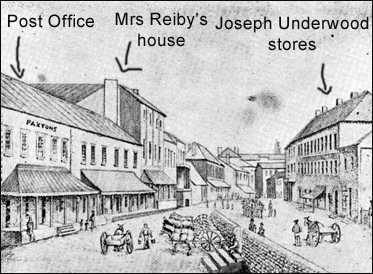In the ‘forties the premises were owned by Messrs. Morehead and Young, and from the Bon Accord Wharf at the rear the bridge of that name, built by this firm, ran across the Tank Stream. The site of the house and of two shops on the north of it is now part of the roadway between the Fire Station and the Commissariat stores, the station occupying the site of the next-door house, seen in the picture.
The latter house brings before us another historic character in the person of Mrs. Reibey, claimed by some authorities as the original Margaret Catchpole, who built this house in 1811-12, and who became Sydney’s first woman merchant. She was married to Captain Raby (the name was afterwards changed to Reiby or Reibey), who died in 1811. Mary Reibey boldly tackled the management of the business they had embarked in, and not only maintained but built it up. From this house she advertised, in December 1811, that “tea, sugar, salt, bacon, pork, etc., are for sale.” She owned other properties in the city, the most notable being that in Macquarie-place at the corner of Reibey-lane, where the Bank of New South Wales was born.
The picture of 1829 brings before us a Sydney far removed from this age of trams and motor cars. Bullock waggons and a group of aboriginals in George street today would excite almost as much interest as a motor car would have ninety years ago.

In the picture of 1847, it will be noticed that the modern awning has its forerunner in the shape of verandahs, and the prototype of the delivery waggon of to-day may be seen backed against the wall. This wall divided George street into a high level leading to Miller’s
Point and a low level running down to the Queen’s wharf and the wharves at the rear of these houses. In the two three-story houses next to Mrs. Reibey’s were located G. Mackellar, wholesale druggist, and Dr. F. Mackellar. The next building was the business premises of Lane and Company, ship-chandlers, a name well-known in shipping circle for many years.
